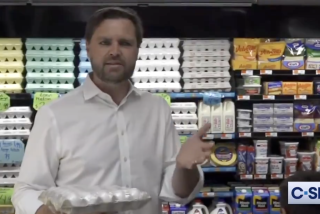Inflation: Hiccup or Indigestion? : Greenspan May Be Caught Between Recession and Price Spiral
- Share via
Nothing must be more troubling to Alan S. Greenspan, President Reagan’s nominee to succeed Paul A. Volcker as the chairman of the Federal Reserve Board, than the recent run-up of inflation. For the first half of 1987 the consumer price index increased at an annual rate of 5.4%. By contrast, it rose only 1.1% in 1986. Greenspan’s immediate prospects depend heavily on whether this jump is a temporary hiccup or something more.
At his Senate confirmation hearing Greenspan made the customary worthless pledges to fight inflation. The only true test is whether he is willing to tolerate a recession to combat rising inflation. If inflation has increased to 5%, that’s probably what it will take.
Three decades of struggling against inflation have not revealed subtle or gentle ways of treating it. The traditional medicine is the only one that ultimately works. Higher unemployment and weak spending dampen price and wage increases. Businesses compete more ferociously for sales by discounting prices. Workers become more fearful of unemployment, and accept lower wage or salary increases.
Greenspan surely knows this, just as he knows that a recession would complicate his job enormously. He would become instantly unpopular. Moreover, any recession that checked inflation would have some nasty side effects. The federal budget deficit would widen as taxes fell and government spending on unemployment and welfare benefits rose. The Third World debt crisis would probably worsen. Failures of banks and savings-and-loan associations might increase as bad loans multiplied.
The inflation outlook, then, holds Greenspan hostage. For the moment, the odds favor the hiccup theory: Just as oil-price declines temporarily depressed inflation last year, so oil-price increases in 1987 have temporarily raised it. Higher food prices have made matters worse. These increases (so the argument goes) won’t continue, and inflation will settle back to about 4%. Not great, but in line with recent experience. Between 1982 and 1985 the consumer price index increased an average of 3.9% annually.
The best inflation news is that underlying cost pressures remain mild. Wage and fringe-benefit costs, the biggest expenses for most businesses, are increasing at a rate of 3.4% annually. In 1980 the increase was 10.4%. Companies typically pass along higher labor costs in the form of higher prices unless they can offset the increases with better efficiency. These productivity gains amounted to 0.7% in 1986. Thus, labor-cost inflation is now running at about 2.7% (the 3.4% increase in wage and fringe benefits minus the 0.7% productivity gain).
Paradoxically, rising oil and food prices earlier this year are now a favorable sign. Together, these increases have accounted for more than one-third of the inflation so far in 1987. If these increases slow or stop, and nothing else changes, inflation would automatically subside.
For example, tight supplies of meat increased prices of food at an annual rate of 4.4% in the first half of 1987. But lower prices of feed grains are now promoting production, and they should reduce meat prices starting in the second half of 1987.
The Organization of Petroleum Exporting Countries raised crude-oil prices by about $4 a barrel, or 29%, in early 1987, but few analysts expect similar increases for the rest of 1987 or in 1988.
Of course, forecasting inflation is a fool’s game. Almost no one gets it right. For every good reason for lower inflation, there’s a good reason for higher inflation. The U.S. economy is now in its fifth year of recovery from the 1981-82 recession. Unemployment (6.1% in June) is at its lowest point since late 1979. Wage gains could accelerate. High demand may permit companies to raise prices and profit margins. Further depreciation of the dollar, which tends to raise import prices, would also worsen inflation.
No one asked Greenspan at his confirmation hearing what he considers acceptable inflation. Perhaps anything below a 1%-2% level is impractical because our price statistics are imperfect. The trickiest problem is measuring quality improvements: A better product often costs more, but the higher price isn’t true inflation.
But a 5% inflation rate is not a statistical fluke, and ought to be unacceptable. To tolerate it would risk repeating the disastrous experience of the 1960s and 1970s. Small rises in inflation were rationalized as relatively harmless. One increase led to another, ending in a stubborn wage-price spiral and double-digit inflation.
When Volcker arrived at the Federal Reserve in 1979, the economy was a shambles. If he hadn’t improved it, the worst that might have been said was that he inherited a mess. Taming inflation made him a legend. Greenspan is now left with the more tedious job of preserving this gain. There is more opportunity for error and less for great achievement. Volcker’s glory could be Greenspan’s grief.
More to Read
Get the L.A. Times Politics newsletter
Deeply reported insights into legislation, politics and policy from Sacramento, Washington and beyond. In your inbox twice per week.
You may occasionally receive promotional content from the Los Angeles Times.









